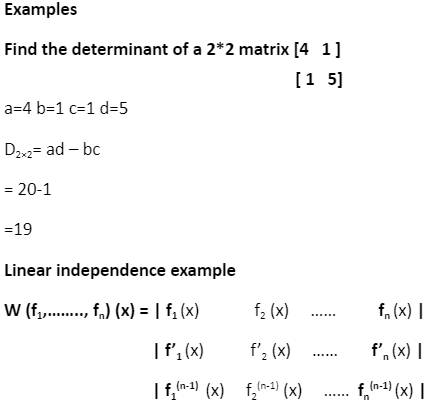Determinant properties are needed to find the value of the determinant with the least calculations. Determinant properties are based on element, row, and column operations to help you easily find the value of the determinant.
The seven important characteristics of the determinant are:
Interchange Property: Swapping a row or column in a determinant does not change the value of the determinant. From this property, if the rows and columns of the matrix are exchanged, the transposed matrix is preserved and the value of the determinant and the transposed determinant are the same.
Sign Property: When two rows or two columns are exchanged, the sign of the determinant value changes. The value of the determinant changes the sign only if the row or column is swapped once. In Matrix A above, the second row is swapped for the third row to get Matrix B, where Det (A) = Det (B). If the value of the determinant is D and the row or column is swapped n times, the new value of the determinant is (-1)nD
Null property: If two rows or two columns contain the same element, the value of the determinant will be zero. Here, the elements in the first and second rows are the same. Therefore, the value of the determinant is zero and so, Det (A) = 0
Multiply property: When each element of a particular row or column is multiplied by the constant k, the value of the determinant is k times the previous value of the determinant. The element in the first row is multiplied by the constant k, and the value of the determinant is also multiplied by the constant k. This property helps you get the common elements from each row or column of the determinant. The value of the determinant is zero, even if the corresponding elements of any two rows or columns are equal.
Sum Properties: A determinant can be represented as the sum of two or more determinants if some elements of the row or column are represented as sums of terms. The elements in the first row represent the sum of the terms that can be split into two different determinants. In addition, the new determinant has the same second and third rows as the previous determinant.
Indefinite property: If each element of a row and column of a determinant is added to another multiple of the elements of another row or column of the determinant, the value of the determinant does not change. This can be expressed in mathematical form as Ri = Ri + kRj, or Ci = Ci + kCj. The elements of the first row of matrix A have been replaced with the sum of the elements of the first row, and the third row multiplied with a constant, to obtain the new matrix B. Here, after this operation also, the determinant A is equal to determinant B.
triangle property. If the elements above or below the main diagonal are zero, the value of the determinant is equal to the product of the diagonal elements of the matrix.
Purpose of determinants
You can use the determinant to give an explicit equation for solving a system of n equations with n unknowns and an inverse matrix of the inverse matrix. It can also be used to give an area/volume equation for a particular geometry.
The determinant can be used to characterize that the linear dependent vector is zero only if the column vector (or equivalent row vector) of matrix A is linearly dependent. For example, given two linear independence vectors v, the third vector has the first two vectors only if the determinant of the 3× 3 matrices consisting of three vectors is zero. It is on a straddling plane.
You can think of a determinant as assigning a number to each sequence of n vectors in Rn, using a square matrix whose columns are the specified vectors. For example, an orthogonal matrix with an entry in Rn represents an orthonormal basis in Euclidean space. The determinant of such a matrix determines whether the direction of the basis is the same as or opposite to the direction of the standard basis. If the determinant is +1 then the base orientation is the same. If -1, the orientation of the base is reversed.

Conclusion
The study of certain forms of determinants was a natural result of completing the general theory. Axisymmetric determinants were studied by Lebesgue, Hesse, and Sylvester. Inverse matrix of Sylvester and Hankel. Catalan, Spottiswoode, Glacier, Scott circulator. Diagonal determinants and Pfaffians in the context of Kaley’s orthogonal transformation theory. The sequel to Sylvester. Wronskian determinant by Christoffel and Frobenius (named by Muir). Composite determinant from Sylvester, Reiss, and Picket. Jacobian and Hesse of Sylvester. Toldi’s symmetric Gauche determinant. Spottiswoode was the first textbook on this subject. The paper was published in the United States by Hanus (1886), Weld (1893), and Muir / Metzeler (1933).
 Profile
Profile Settings
Settings Refer your friends
Refer your friends Sign out
Sign out













